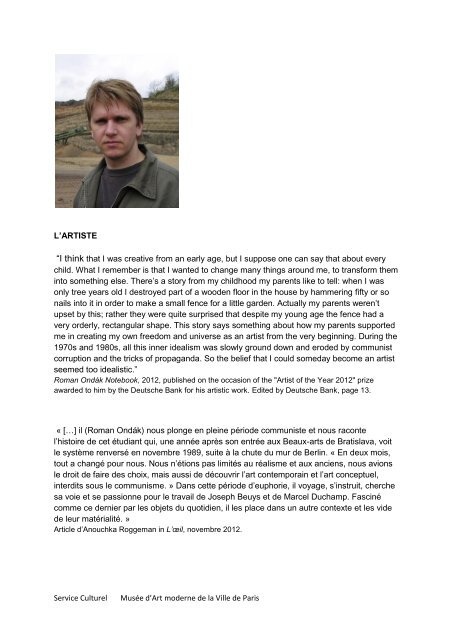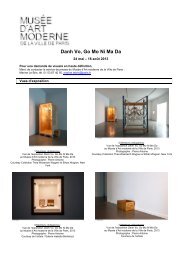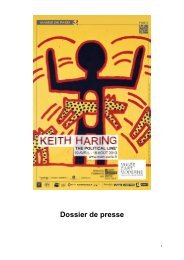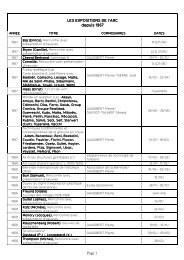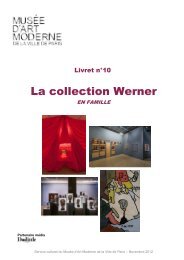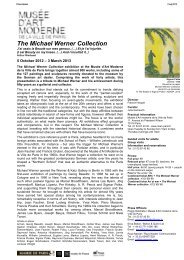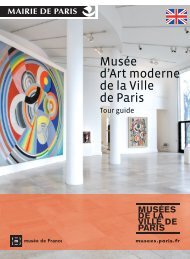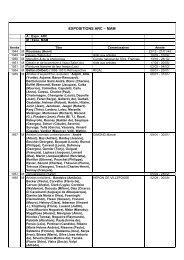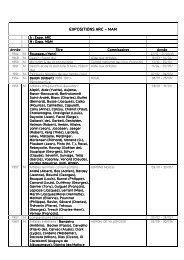Roman Ondak - Musée d'Art Moderne - Ville de Paris
Roman Ondak - Musée d'Art Moderne - Ville de Paris
Roman Ondak - Musée d'Art Moderne - Ville de Paris
You also want an ePaper? Increase the reach of your titles
YUMPU automatically turns print PDFs into web optimized ePapers that Google loves.
L’ARTISTE<br />
“I think that I was creative from an early age, but I suppose one can say that about every<br />
child. What I remember is that I wanted to change many things around me, to transform them<br />
into something else. There’s a story from my childhood my parents like to tell: when I was<br />
only tree years old I <strong>de</strong>stroyed part of a woo<strong>de</strong>n floor in the house by hammering fifty or so<br />
nails into it in or<strong>de</strong>r to make a small fence for a little gar<strong>de</strong>n. Actually my parents weren’t<br />
upset by this; rather they were quite surprised that <strong>de</strong>spite my young age the fence had a<br />
very or<strong>de</strong>rly, rectangular shape. This story says something about how my parents supported<br />
me in creating my own freedom and universe as an artist from the very beginning. During the<br />
1970s and 1980s, all this inner i<strong>de</strong>alism was slowly ground down and ero<strong>de</strong>d by communist<br />
corruption and the tricks of propaganda. So the belief that I could someday become an artist<br />
seemed too i<strong>de</strong>alistic.”<br />
<strong>Roman</strong> Ondák Notebook, 2012, published on the occasion of the "Artist of the Year 2012" prize<br />
awar<strong>de</strong>d to him by the Deutsche Bank for his artistic work. Edited by Deutsche Bank, page 13.<br />
« […] il (<strong>Roman</strong> Ondák) nous plonge en pleine pério<strong>de</strong> communiste et nous raconte<br />
l’histoire <strong>de</strong> cet étudiant qui, une année après son entrée aux Beaux-arts <strong>de</strong> Bratislava, voit<br />
le système renversé en novembre 1989, suite à la chute du mur <strong>de</strong> Berlin. « En <strong>de</strong>ux mois,<br />
tout a changé pour nous. Nous n’étions pas limités au réalisme et aux anciens, nous avions<br />
le droit <strong>de</strong> faire <strong>de</strong>s choix, mais aussi <strong>de</strong> découvrir l’art contemporain et l’art conceptuel,<br />
interdits sous le communisme. » Dans cette pério<strong>de</strong> d’euphorie, il voyage, s’instruit, cherche<br />
sa voie et se passionne pour le travail <strong>de</strong> Joseph Beuys et <strong>de</strong> Marcel Duchamp. Fasciné<br />
comme ce <strong>de</strong>rnier par les objets du quotidien, il les place dans un autre contexte et les vi<strong>de</strong><br />
<strong>de</strong> leur matérialité. »<br />
Article d’Anouchka Roggeman in L’œil, novembre 2012.<br />
Service Culturel <strong>Musée</strong> d’Art mo<strong>de</strong>rne <strong>de</strong> la <strong>Ville</strong> <strong>de</strong> <strong>Paris</strong>


